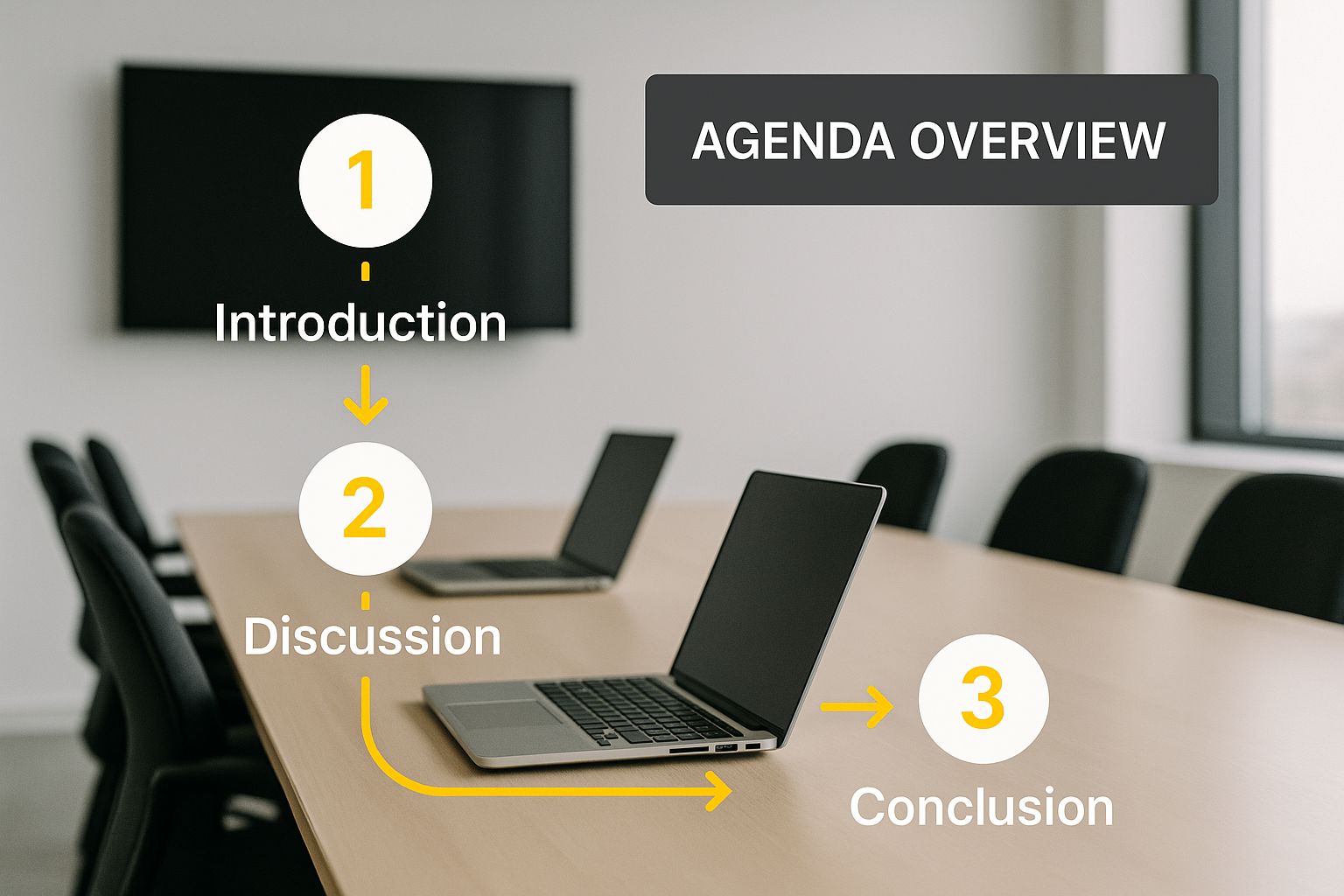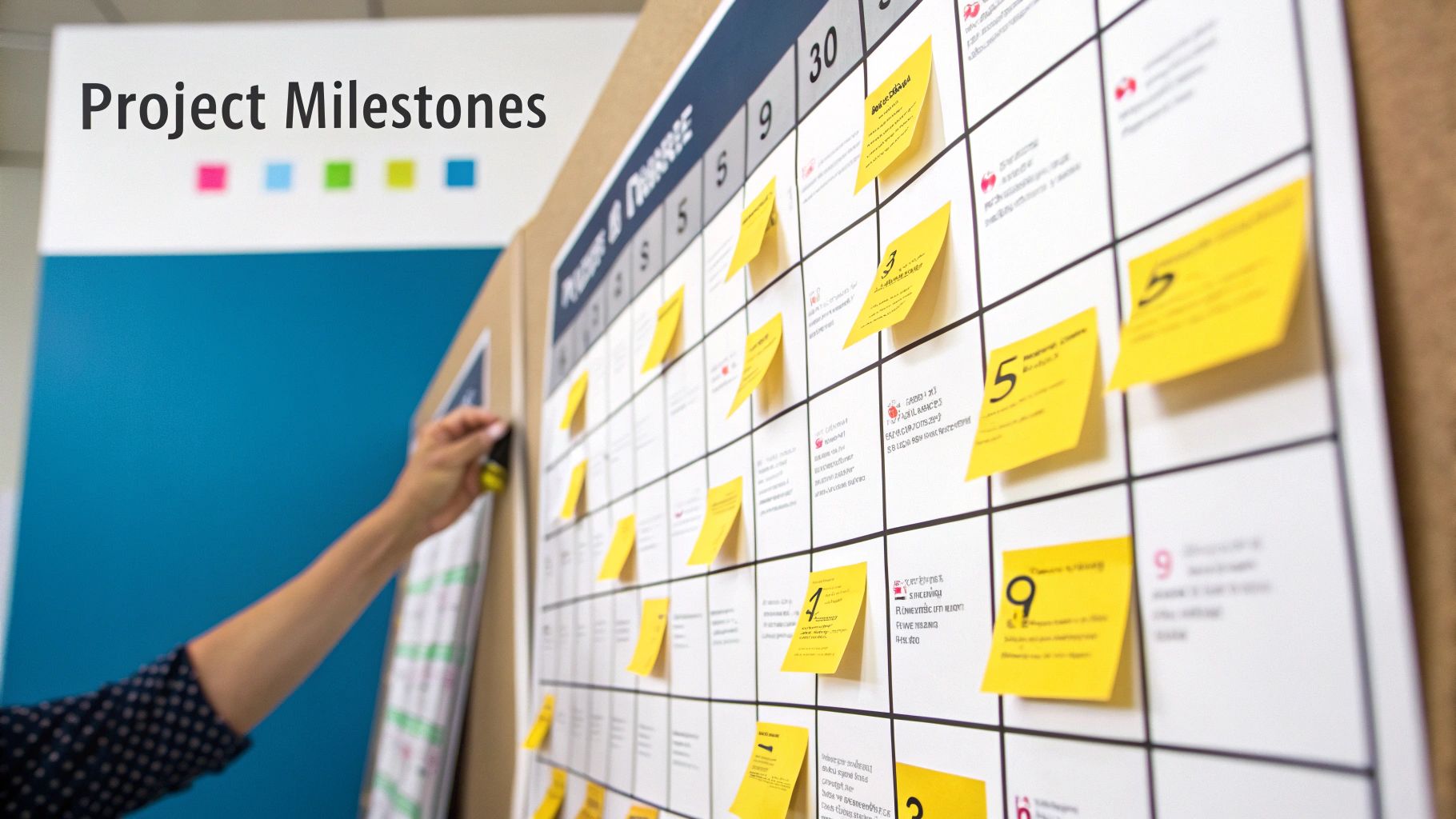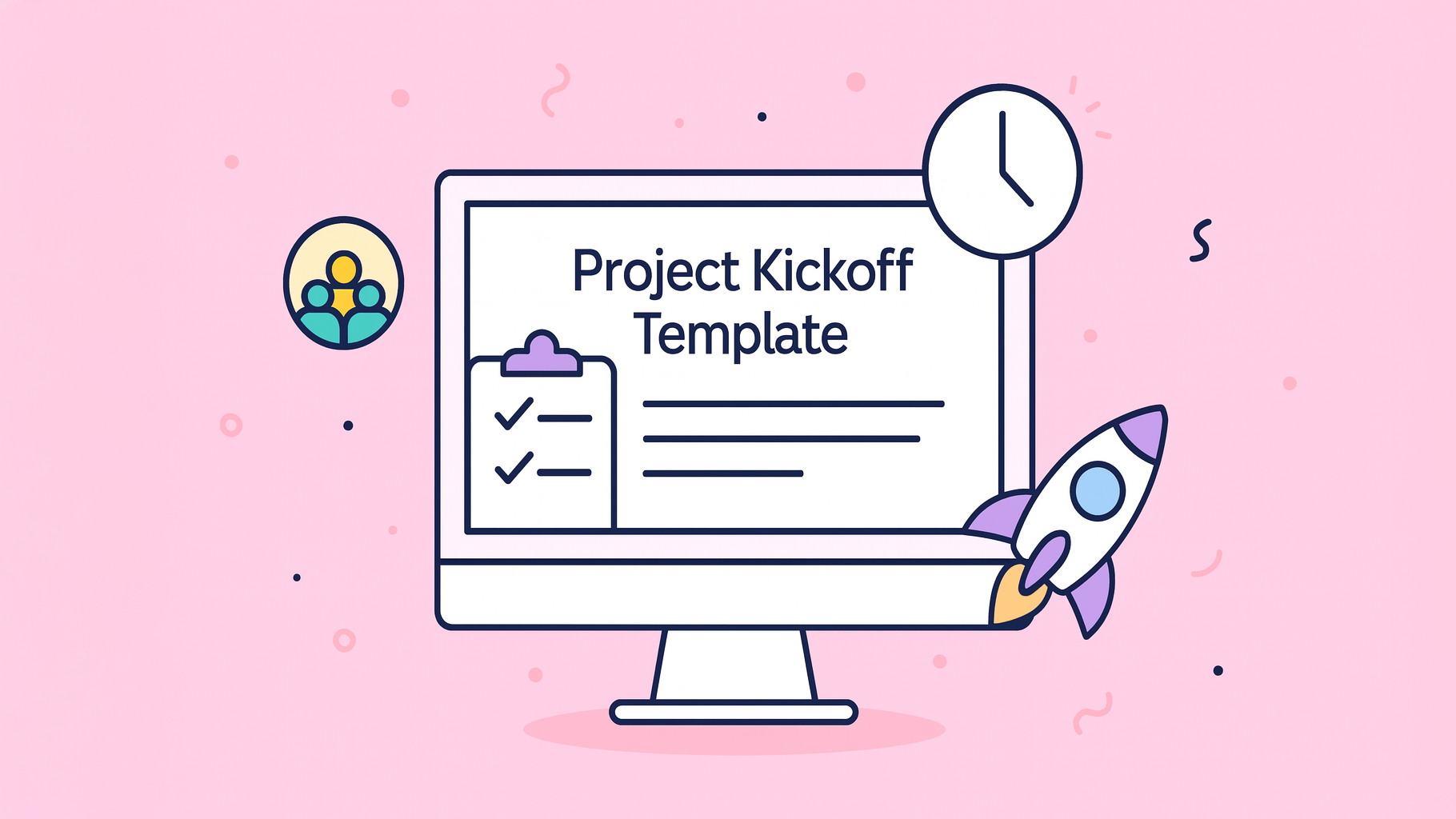A great project kickoff meeting template is so much more than a simple agenda; it’s a strategic tool that can make or break your project’s success. When done right, it ensures everyone starts on the same page about goals, scope, and roles, which is your best defense against the costly misunderstandings that always seem to pop up later.
Think of this first structured meeting as your single best weapon against scope creep and team burnout.
Why Your Project Kickoff Defines Its Success
I like to think of a project kickoff as the foundation of a house. You can have the best materials and the most skilled builders, but a weak, rushed foundation will inevitably lead to structural problems down the road. It’s the same with projects. A poorly executed kickoff—or worse, skipping it entirely—sets a project up for failure before the first task is even assigned.
This isn’t just about ticking a box. The kickoff is arguably the most important meeting in the entire project lifecycle. It’s your first and best chance to transform a group of individuals into a unified team, build momentum, and establish a culture of clear, proactive communication.
From Theory to Tangible Results
Let’s look at a real-world scenario that plays out all too often. Imagine a software development project that starts without a formal kickoff. The team gets a brief, everyone nods, and they jump straight into coding. A few weeks later, the client sees a demo and their face drops. “This isn’t what we discussed at all,” they say. Suddenly, the developers are frustrated, the client is fuming, and thousands of dollars in development time have gone down the drain.
Now, let’s rewind and start that same project with a proper kickoff meeting. The project manager uses a solid template to guide the conversation. They confirm the project’s why, get everyone to agree on what’s in scope and out of scope, and hash out roles and responsibilities right there in the room. When a developer asks a clarifying question about a specific feature, the client gives immediate feedback, instantly preventing a major disconnect. The team walks out of that meeting energized and crystal clear on their mission.
This isn’t just a nice story. The data backs it up. Projects with structured kickoff meetings have approximately a 33% higher success rate. Even better, effective kickoffs lead to much better risk management, with teams reporting up to 40% fewer unforeseen obstacles popping up mid-project. It’s a proven model—just look at how NASA propels projects to success with meticulous planning from day one.
Before we dive into the template, let’s summarize what makes a kickoff so powerful. It’s not just a checklist; it’s a strategic alignment session.
| Element | Purpose | Key Outcome |
|---|---|---|
| Shared Vision | To ensure everyone understands the “why” behind the project. | A motivated team with a clear sense of purpose. |
| Scope Definition | To clearly define what is in and out of the project’s boundaries. | Drastically reduced scope creep and rework. |
| Role Clarity | To assign and clarify each person’s responsibilities. | Empowered team members who can work autonomously. |
| Risk Identification | To proactively identify and discuss potential roadblocks. | A clear plan to mitigate issues before they escalate. |
| Communication Plan | To set expectations for how the team will communicate. | Fewer misunderstandings and a more collaborative environment. |
A well-executed kickoff meeting, built around these core elements, sets the stage for a project that runs smoothly from start to finish.
The Strategic Value of Alignment
Ultimately, the kickoff’s primary job is to create alignment. When your team is truly aligned from the get-go, you’ll see incredible benefits ripple through the entire project:
- Reduced Scope Creep: With clear, agreed-upon boundaries, there’s no room for ambiguity.
- Increased Efficiency: People know exactly what they’re responsible for and can get to work without needing constant hand-holding.
- Improved Morale: Clarity and open communication prevent the burnout that comes from confusing direction and endless rework.
- Proactive Risk Management: The kickoff is the perfect forum to surface potential risks when they are cheapest and easiest to solve.
This initial alignment is especially vital when you’re bringing different departments or platforms together. It’s why so many successful projects rely on getting everyone in sync from day one, like when you need to get different teams on the same page with a HubSpot Jira integration.
Investing just an hour or two in a powerful kickoff meeting delivers an incredible return, setting the stage for a project that finishes on time, within budget, and with a happy, motivated team.
The Complete Project Kickoff Meeting Template
A great project kickoff meeting template is more than just a checklist; it’s your game plan for guiding the conversation. I’ve seen this structure succeed whether the project is a new app, a massive marketing campaign, or an internal process overhaul. Think of it as a script, but one that encourages improv and ensures everyone leaves on the same page.
Below is a field-tested template you can pretty much copy and paste. But here’s the key: for each item, I’ve included facilitator prompts and the exact questions I use to get real, meaningful discussions going. This is how you turn a standard meeting into a project’s launchpad.
This infographic gives you a quick, high-level view of how all the pieces fit together.

As you can see, it’s all about a logical flow—from getting to know each other to walking away with concrete next steps.
Welcome and Introductions (5 Minutes)
First things first, you need to set a collaborative tone and make sure everyone knows who’s who. It’s about more than just names and titles; it’s about establishing context and connection right from the start.
Facilitator Prompt: “Let’s go around the room. Please share your name, your role on this project, and one specific thing you’re excited to contribute.”
This little twist encourages people to think about the value they bring from day one. It’s a simple way to break the ice and frame the entire meeting in a positive, proactive light.
The Project’s “Why” and Vision (10 Minutes)
This is your moment to connect the dots and show how this project fits into the bigger picture. People are infinitely more motivated when they understand the purpose behind their work. If you can, have the project sponsor lead this part—it adds a layer of authority and importance.
Key Questions to Ask:
- What problem are we actually solving for our customers or for the business?
- What does success look like in six months? If we nail this, what will have changed?
- How does this project directly support our company’s strategic goals for this quarter or year?
Pro Tip: Make the vision concrete. Don’t just say, “We want to improve the user experience.” Instead, try something like, “Our goal is to create a checkout process so seamless that we reduce cart abandonment by 15%.” Numbers make it real.
Defining Project Scope (15 Minutes)
Pay attention, because this is probably the most critical part of the entire meeting. I can’t tell you how many projects go off the rails because of scope ambiguity. Your one job here is to get firm, vocal agreement on the project’s boundaries.
Clearly outline what is in scope. For a new website launch, for instance, this might be the homepage, product pages, and a blog. Then, be just as explicit about what is out of scope. That could be a customer forum or e-commerce features, which you can park for a future phase.
Facilitator Prompt: “Based on what we’ve just discussed, does everyone agree on these boundaries? Are there any grey areas we need to nail down right now?”
Getting this documented is absolutely essential. To dig deeper into this, you can check out this detailed guide on crafting an effective project kickoff agenda, which has some great techniques for locking down scope.
Roles and Responsibilities (10 Minutes)
Clarity here is what prevents duplicated work and dropped balls down the line. This isn’t about job titles; it’s about project-specific responsibilities. Who does what?
- Who is the Project Sponsor? (The person championing the project and holding the final say.)
- Who is the Project Lead/Manager? (The person driving the day-to-day execution.)
- Who are the Key Contributors? (The core team members actually doing the work.)
- Who are the primary Stakeholders? (The people who need to be kept in the loop or consulted.)
A RACI (Responsible, Accountable, Consulted, Informed) matrix is a fantastic tool for this, but even a simple list confirmed during the meeting is a massive win.
Communication Plan and Tools (10 Minutes)
Even the best plans will crumble under the weight of poor communication. You need to set crystal-clear expectations for how the team will stay connected.
Key Questions to Ask:
- How often will we have team meetings? (Think daily stand-ups or weekly check-ins.)
- What’s our go-to tool for quick, ongoing chats? (Like Slack or Microsoft Teams.)
- Where is the official source of truth for project documents? (Maybe Confluence, SharePoint, or Google Drive.)
- How will we share status updates with stakeholders? (A weekly email summary? A dashboard?)
Nailing down these ground rules from the outset prevents so much confusion and ensures information gets to the right people at the right time.
Next Steps and Action Items (5 Minutes)
Never, ever end a meeting without clear, actionable momentum. All that energy and alignment you just built can evaporate in minutes if you don’t give it a direction.
Facilitator Prompt: “Before we wrap up, let’s confirm our immediate next steps. I’ll send out a summary of today’s meeting, including all action items with owners and due dates, by the end of the day.” This simple statement solidifies commitments and officially shifts the project from planning into execution.
How to Prepare for a Flawless Kickoff

Here’s a hard truth: a kickoff meeting is won or lost long before anyone logs into the video call. The quality of your prep work directly dictates the quality of the meeting itself. Skimp on it, and you’re inviting a session that spirals into confusion, gets bogged down in minor details, or worse, ends with zero concrete commitments.
Your goal is to shift the meeting from a passive info-dump into an active, decision-making workshop. That whole process starts with a deceptively simple task: figuring out who should actually be in the room.
Curate Your Attendee List
A crowded room is where good ideas go to die. Your first job is to be ruthless with that invite list. It’s so tempting to invite people “just in case” or to include entire departments for the sake of politics. Don’t. Every single person in that meeting needs a specific, active role.
For every name you consider adding, ask yourself these questions:
- Why is this person essential? Are they a key decision-maker, doing the actual work, or providing a perspective no one else has?
- What will they contribute? Can they speak to the budget, technical limitations, or client expectations with authority?
- What do they need from this meeting? Is their presence vital for alignment, or could they just get the summary afterward?
If you can’t nail down a clear “why” for someone’s attendance, they probably don’t need to be there. A smaller, more focused group will always outperform a crowd.
Distribute Materials in Advance
Never, ever let the kickoff be the first time your team sees the project’s core documents. Sending the agenda and key materials at least 48 hours beforehand is a non-negotiable sign of respect for everyone’s time.
Your pre-meeting package should be concise but comprehensive:
- The project kickoff meeting template or a clear agenda you’ll be following.
- A one-page project charter or vision document.
- Any high-level scope documents or a short list of requirements.
This isn’t just homework; it’s about getting people to show up ready to engage and decide, not just listen and absorb. In a remote world, this prep has a massive impact. A recent survey showed that 72% of project managers running virtual kickoffs saw better team alignment when agendas were shared early.
Pro Tip: Grab 15 minutes with your project sponsor before the kickoff. This isn’t a pre-meeting; it’s a quick alignment check. Confirm they’re on the same page with the goals and ask if they have any hidden concerns. This one conversation can prevent a senior stakeholder from derailing the entire meeting with a surprise objection.
Finally, show up ready to lead. As the project manager, you need to know the project charter cold. Anticipate the sticking points—whether it’s budget worries or scope creep—and think through how you’ll guide those conversations. This level of readiness is what separates a routine meeting from a truly flawless kickoff. It’s a foundational practice, much like the structured communication we see in other agile ceremonies. In fact, many of these principles of clarity and preparation are echoed in our comprehensive guide to stand-up meetings for Scrum Masters.
Running Your Meeting for Maximum Engagement

The best project kickoff meeting template in the world is just a document until you bring it to life. This is where your skill as a facilitator truly shines. Your role isn’t to be a presenter reading off slides; it’s to be a guide.
You’re there to create an environment where real discussion, debate, and—most importantly—commitment can happen. This is a big deal, especially in hybrid settings where it’s all too easy for remote team members to fade into the background.
A simple way to set the right tone from the get-go is to make it clear this is an interactive session. Try this at the start: “For the next 90 minutes, let’s use our laptops for notes only, not for checking email. This project deserves our full attention.” A small request like this sends a powerful message about focus.
Fostering Active Participation
One of the most common hurdles is getting everyone to contribute, not just the loudest people in the room. A technique I’ve found incredibly effective is the “round-robin,” especially for critical topics.
For instance, when you get to the project risks section, don’t just ask, “So, any risks?” That’s a recipe for silence. Instead, go around the physical or virtual table and ask each person to name one potential risk. This simple change ensures even the quietest team members have a dedicated moment to share their thoughts.
What if someone is dominating the conversation? You can gently guide it back on track. Try saying something like, “That’s a great point, John. I’ve got that noted. Sarah, I’d love to get your perspective on this from a design standpoint.” This acknowledges the contribution while skillfully passing the conversational baton. For more inspiration, you can find a ton of other ideas to boost meeting engagement that work perfectly in a kickoff setting.
Securing Buy-In On Roles And Responsibilities
This is a critical moment. It should feel like a hands-on workshop, not a lecture. Don’t just present a slide with names and roles. Instead, put the list on the screen and walk through it interactively, asking direct questions to get public commitment.
- “Maria, we have you down as the lead for user testing. Are you comfortable with that scope and the initial timeline?”
- “David, you’re our go-to for any technical questions. Is everyone clear that David is the primary contact here?”
Getting that verbal “yes” in front of the group is far more powerful than a silent nod. In fact, this single act of clarifying roles in the kickoff has a massive impact. Projects that nail this see a 25-30% improvement in on-time task completion, purely because it replaces fuzzy assumptions with explicit agreements.
Common Kickoff Challenges and How to Handle Them
Even with the best-laid plans, kickoffs can hit a few snags. Over the years, I’ve seen the same issues pop up time and again. The key is to anticipate them so you can steer the meeting back on course without losing momentum.
Here’s a quick guide to some common challenges and how you can proactively manage them.
| Challenge | Why It Happens | Proactive Solution |
|---|---|---|
| Key Stakeholder is a No-Show | Scheduling conflicts, last-minute emergencies, or they don’t see the value. | Pre-wire the meeting with them 1-on-1 to get their input beforehand. Record the session and send them a summary with specific questions for their feedback. |
| The “Scope Creep” Question | Someone asks for a feature or deliverable that’s clearly out of scope. | Acknowledge the idea’s value. Use a “parking lot” (a visible list of topics to discuss later) and say, “That’s a great idea for Phase 2. Let’s add it to our parking lot so we don’t lose it.” |
| Awkward Silence / Low Energy | The team doesn’t know each other well, or it’s early in the morning. | Start with a quick, low-pressure icebreaker related to the project. For example, “In one word, what are you most excited about for this project?” |
| Technical Rabbit Holes | Engineers or technical leads start a deep-dive discussion that loses the rest of the audience. | Intervene politely: “This is a crucial technical detail. Let’s you and I sync up right after this meeting to dive deeper and then share a summary with the team.” |
Thinking through these scenarios beforehand will make you look like a seasoned pro who can handle anything the meeting throws at you.
Key Takeaway: The kickoff meeting isn’t just about sharing information; it’s about securing commitments. When people publicly agree to their roles and responsibilities in front of their peers, they are far more likely to follow through.
By actively facilitating, you elevate the meeting from a passive update into a dynamic launch event. You’ll walk out of that room not just with a checked-off agenda, but with a team that feels aligned, heard, and genuinely fired up to get started. This is how you turn the initial energy of a kickoff into real, sustained project momentum.
Turning Kickoff Momentum Into Action
The energy you get from a great project kickoff is powerful, but it’s also incredibly fragile. If you don’t act on it immediately, all that alignment and motivation can evaporate before the first real task even begins. The single most important thing to do after the meeting is send a swift, comprehensive summary email.
This isn’t just a formality; it’s the official starting gun for the project. This follow-up solidifies everything that was discussed and agreed upon. It turns verbal commitments into a documented record, leaving no room for misunderstandings about what comes next.
Crafting the Perfect Follow-Up
Your follow-up email needs to land in everyone’s inbox within a few hours of the meeting, while the details are still fresh. It doesn’t have to be a novel, but it must be crystal clear and actionable.
Here’s what it should cover:
- A quick thank you to everyone for their time and focus.
- A link to the detailed meeting notes, which should live in a shared space like Confluence or a Google Doc.
- A concise recap of the key decisions, especially around the project’s scope and goals.
But the most critical part of this email is the action items section.
Don’t just list out tasks. Every single action item needs a clear owner and a specific due date. This simple act is what turns a conversation into real accountability and actually drives the project forward.
From Kickoff to Cadence
Once that follow-up is sent, your very next move is to get the team into its working rhythm. Don’t wait a week to schedule the first “real” project meeting—that’s a surefire way to lose all the momentum you just built. You have to capitalize on that energy now.
For an agile project, this means the first daily stand-up is scheduled for the very next morning. If your project is more traditional, get that first weekly check-in on the calendar right away. The goal is to make the project’s heartbeat tangible from day one. To effectively turn that initial momentum into sustained action, it helps to have a clear mobile app development roadmap to guide your team’s next steps.
This seamless transition proves to the team that the kickoff wasn’t just a one-off ceremony. It was the genuine start of a well-orchestrated effort. By documenting what you agreed on and immediately establishing a working cadence, you transform the high-level energy from your project kick off meeting template into the tangible, day-to-day progress that ultimately leads to success.
Of course, even with the best plan in hand, some practical questions always come up when you’re getting ready to run a kickoff. I’ve been asked these countless times, so let’s walk through the most common ones. Getting these details right can make all the difference.
How Long Should a Kickoff Meeting Be?
The sweet spot is usually 60 to 120 minutes.
For a pretty straightforward internal project with a team that already knows each other, an hour is often plenty. But for a more complex initiative, especially one involving multiple client stakeholders, you’ll want to block out the full two hours. Anything longer than that, and you’ll see people’s energy and attention start to fade fast.
Whatever you decide, state the duration clearly in the invite. Then, do everything you can to stick to it. Respecting everyone’s time is a simple but powerful way to build trust right from the start.
Who Absolutely Must Attend the Kickoff?
I know it’s tempting to invite anyone who might be involved, but fight that urge. An overcrowded kickoff can kill productive discussion and make decision-making nearly impossible. Your invite list should be lean and purposeful.
Here’s who truly needs to be in the room:
- The Core Team: These are the folks who will be doing the actual day-to-day work on the project.
- The Project Sponsor: This is the person with the ultimate authority to make decisions and control the budget.
- Key Stakeholders: Think of the main client contact or the department heads whose input is non-negotiable for the project to succeed.
If you can’t articulate a specific reason for someone to be there, they can probably catch up with the meeting summary later.
In all my years of running projects, the single biggest mistake I see is a failure to get crystal clear on the project scope during the kickoff. And that includes defining what is explicitly out of scope. This one fuzzy area is the number one reason scope creep happens later. Use this meeting to get firm, documented agreement on the project’s boundaries.
Can You Run a Kickoff Meeting Asynchronously?
While a live, real-time meeting is always best for building that initial team energy and rapport, a hybrid approach can work, especially for distributed teams. That live, interactive element is just too valuable for hashing out complex topics like risks and roles.
What I’ve found works well is to pre-record some of the one-way information, like the project background or a demo of the core problem. Have everyone watch it on their own time. Then, you can use the precious live session for what it’s truly for: genuine discussion, Q&A, and making key decisions together.
Of course, great follow-up documentation is non-negotiable in a remote or hybrid setup. To keep everyone aligned, you’ll need to master the art of capturing effective meeting notes and action items, no matter where your team members are.
Ready to transform your agile meetings from routine check-ins into strategic powerhouses? resolution Reichert Network Solutions GmbH presents NASA – Not Another Standup App, the ultimate tool for facilitating focused, efficient, and collaborative meetings directly within Jira. Streamline your kickoffs and all your agile ceremonies with NASA today.
